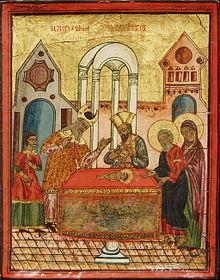Page Two
Feast of the Circumcision of Christ |
|
aka Feast of the Holy Name of Jesus |
Venerated in |
Coptic Orthodox Church, Oriental Orthodox Churches, Eastern Orthodox Churches, Roman Catholic Church, Anglican Communion |
Veneration |
One of the Major 12 Feasts in the Liturgical Year |
Feast |
1st of January |
Biblical accounts
The circumcision of Jesus is an event from the life of Jesus according to the Gospel of Luke, which states in verse 2:21 that Jesus was circumcised eight days after his birth (traditionally January 1). This is in keeping with the Jewish law which holds that males should be circumcised eight days after birth during a Brit milah ceremony, at which they are also given their name. The circumcision of Christ became a very common subject in Christian art from the 10th century onwards, one of numerous events in the Life of Christ to be frequently depicted by artists. It was initially seen only as a scene in larger cycles, but by the Renaissance might be treated as an individual subject for a painting, or form the main subject in an altarpiece.
The event is celebrated as the Feast of the Circumcision in the Eastern Orthodox Church on January 1 in whichever calendar is used, and is also celebrated on the same day by many Anglicans. It is celebrated by Roman Catholics as the Feast of the Holy Name of Jesus, in recent years on January 3 as an Optional Memorial, though it was for long celebrated on January 1, as some other churches still do.
The second chapter of the Gospel of Luke records the circumcision of Jesus:
And when eight days were accomplished for the circumcising of the child, his name was called Jesus, which was so named of the angel before he was conceived in the womb.
However, this account is extremely short, particularly compared to Paul the Apostle's much fuller description of his own circumcision in the third chapter of his Epistle to the Philippians. This led theologians Friedrich Schleiermacher and David Strauss to speculate that the author of the Gospel of Luke might have assumed the circumcision to be historical fact, or might have been relating it as recalled by someone else.
Theological beliefs and celebrations
The circumcision of Jesus has traditionally been seen, as explained in the popular 14th century work the Golden Legend, as the first time the blood of Christ was shed, and thus the beginning of the process of the redemption of man, and a demonstration that Christ was fully human, and of his obedience to Biblical law. Medieval and Renaissance theologians repeatedly stressed this, also drawing attention to the suffering of Jesus as a demonstration of his humanity and a foreshadowing of his Passion. These themes were continued by Protestant theologians like Jeremy Taylor, who in a treatise of 1657 argued that Jesus's circumcision proved his human nature while fulfilling the law of Moses. Taylor also notes that had Jesus been uncircumcised, it would have made Jews substantially less receptive to his Evangelism.
The "Feast of the Circumcision of our Lord" is a Christian celebration of the circumcision, eight days (according to the Semitic and southern European calculation of intervals of days) after his birth, the occasion on which the child was formally given his name, Jesus, a name derived from Hebrew meaning "salvation" or "saviour". It is first recorded from a church council held at Tours in 567, although it was clearly already long-established.
The feast day appears on 1 January in the liturgical calendar of the Eastern Orthodox Church. It also appears in the pre-1960 General Roman Calendar and is celebrated by churches of the Anglican Communion (though in many revised Anglican calendars, such as the 1979 calendar of the Episcopal Church, there is a tendency toward associating the day more with the Holy Name of Jesus) and virtually all Lutheran churches.
It has now disappeared from the Roman calendar, replaced on January 1 by the Solemnity of Mary, Mother of God, but is still celebrated by Old Catholics and some traditionalist Catholics. It was for many centuries combined on January 1 with the Feast of the Holy Name of Jesus, before the two were separated, and now that the Feast of the Circumcision has disappeared as such from the official Catholic calendar, the other feast may be regarded as celebrating this too.
Kourabiedes
Greek New Year's Cookies Recipe
Tradition Total time: more than 2 hours
Preheat the oven at 180°C. (350°F.) Ingredients
Method
These soft, thick cookies are traditionally served on New Year's Day.
Prep. time: 15 minutes
Waiting time: 3 hours
Baking time: 10 minutes
*If the dough is too dense, add a few drops of brandy; if it is too soft, add a touch more flour
**refrigerate for thirty minutes before using a cookie cutter.
QUESTIONS & ANSWERS ON FAITH & TRADITION
Is it a custom in the Syriac-Greek Antiochian Orthodox Catholic Church to offer Benediction of the Blessed Eucharist? (Janice Morgan, Lowell IN)
A. The Syriac-Greek Antiochian Orthodox Catholic Church does perform the paraliturgical service of Benediction of the Blessed Sacrament (Eucharist). It is offered at various times of the year at the discretion of the priest and request of the parishioners. It is celebrated according to the custom of our Church and it does resemble the service as used within the Roman Catholic Church.
Does the Syriac-Greek Antiochian Orthodox Catholic Church follow the Julian (Old) Calendar? (Paul Albano, Joliet IL)
A. The Syriac-Greek Antiochian Orthodox Catholic Church followed the Old Julian Calendar from 1998 until 2008 when it adopted once again the originally-used Gregorian Calendar. Christmas for us is on December 25, as it was at the establishment of our Primatial Archdiocese in America in 1892 under our I Primate, His Beatitude Metropolitan Timotheos Vilathi. Our Archdiocese used the Julian Calendar from a brief period of time from 1997-2003. We respect the use of this calendar by those who do, but differ on the reasons why it is used.
I would like an update on the reunification process between the Syriac-Greek Antiochian Orthodox Catholic Church with the Syriac Orthodox Patriarchate of Antioch. (John Sweeney, Crown Point IN)
A. The Primate, Metropolitan Stephen, met with representatives of the Syriac Patriarchate of Antioch on June 24, 2016. Among those meeting with His Beatitude Metropolitan Stephen and His Eminence Archbishop Timothy Kjera were His Eminence Mor Dionysius Kawak of New Jersey, Deacon George Kiraz, and Dr Sinu John. The meeting was most cordial that included the answering of many questions. We now remain in prayer for a positive response.
*** If you have a question about the Orthodox Catholic Christian Faith or the Syriac-Greek Antiochian Orthodox Catholic Church, please send it to OCH Editor, 456 Nimick Street, Sharon PA 16146. ***
 |
HELP FORM A MISSION PARISH OR LOCAL PRAYER GROUP
The Syriac-Greek Antiochian Orthodox Catholic Archdiocese, like other small Orthodox jurisdictions, realizes that there are members who live far away from the nearest parish to them. In some cases, there are parishes of other jurisdictions that are in inter-communion with us or in which mutual recognition has been exchanged. In such cases our members may attend those churches until one of ours is opened in their locality. In other cases, there are those living in an area with no parish at all to attend, and for them the option is trying to establish a prayer group and hold gatherings to discuss Scripture and Orthodox Catholicism. This is the start that one day can grow into a mission parish with the Typica Service or Liturgy of Mass held in home chapels on Sunday and Holy Days or a rented building. Domestic Chapels and Communities may be established in homes until a parish can be officially established. For further information contact His Eminence Archbishop Timothy at he.timothy@yahoo.com or St Nicholas Center, 456 Nimick Street, Sharon PA 16146. If you are interested in assisting the Archdiocese in establishing a mission parish in your area, please contact us.
